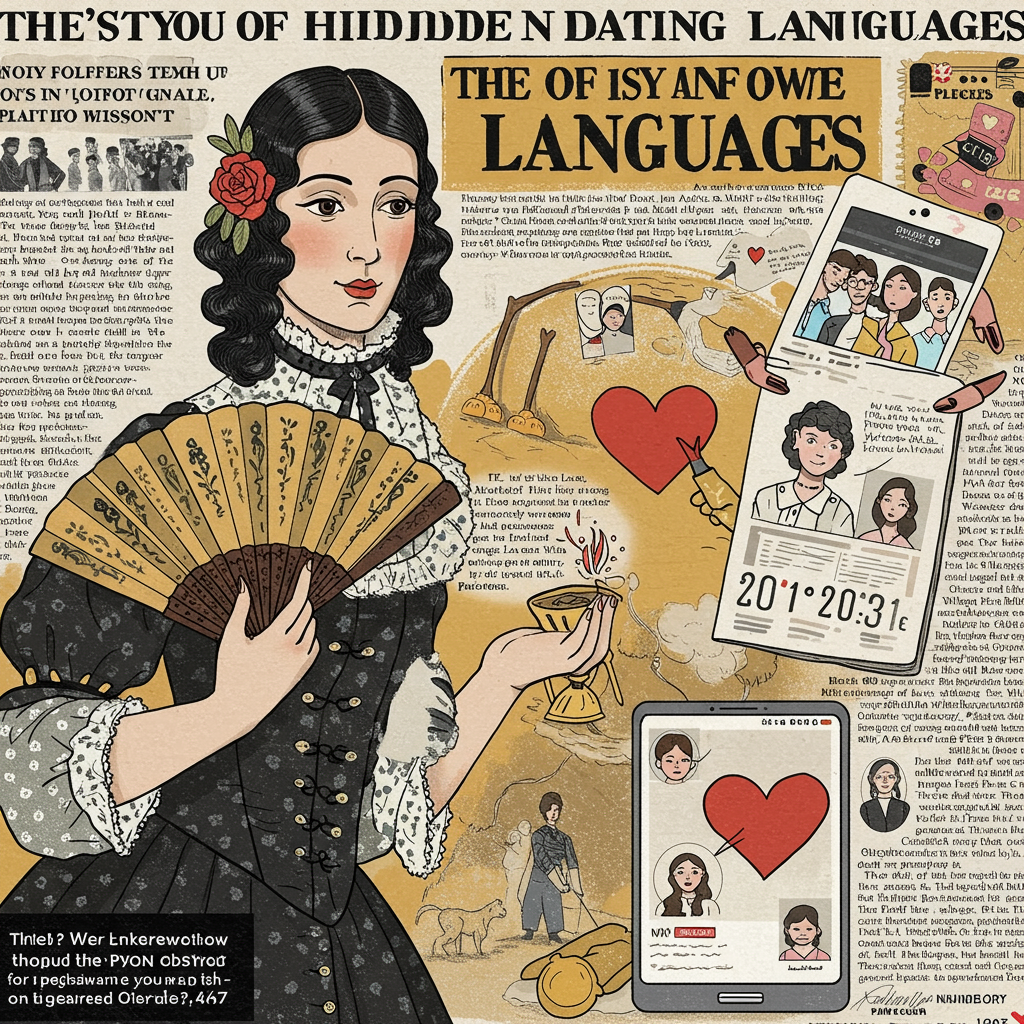Discovering love has always been a complex dance, often relying on more than just spoken words. For centuries, people have used subtle gestures, coded messages, and carefully chosen objects to signal interest, gauge compatibility, and build intimacy. From discreet fan movements in crowded ballrooms to curated online profiles today, these “hidden languages” reveal enduring truths about the human quest for connection. This journey through time explores how visual signals and non-verbal cues have shaped the art of courtship, connecting historical rituals to our modern digital dating world.
The Art of Attraction: From Portraits to Profiles
Long before dating apps required users to swipe left or right based on a photo, visual representation played a crucial role in initiating romantic connections. Consider the striking portrait of Anne of Cleves by Hans Holbein the Younger in 1539. This painting was so persuasive that it led England’s King Henry VIII to propose marriage, despite historical accounts suggesting an awkward and unattractive first meeting in person. The portrait, described by the King’s ambassador as “very lively,” might have exaggerated her beauty, but it served its primary purpose: creating a compelling initial impression.
This historical reliance on images mirrors the dynamics of modern dating platforms. Today, roughly 30% of U.S. adults use dating apps, where initial judgments are heavily influenced by a user’s photograph and a brief bio. Just as Holbein’s portrait aimed to present Anne favorably, users today meticulously select profile pictures and craft descriptions designed to turn heads. These visual first steps underscore that while technology changes, the fundamental human need to make an impactful visual impression in the search for a partner remains constant. Words aren’t always the starting point; often, it’s the image that speaks first.
Regency Courtship: A World of Subtle Signals
The Regency era, spanning the late 18th and early 19th centuries, was a time when the pursuit of marriage was a central social activity. While financial and social prospects often drove unions, the ideal of marrying for love gained significant traction during this period. According to Sally Holloway, a research fellow at Oxford Brookes University and author focused on Georgian England, people increasingly prioritized finding love before marriage, much like assessing compatibility today.
Social events provided fertile ground for subtle flirtation. In crowded ballrooms or drawing rooms, direct conversation between potential partners might be limited or closely observed. This environment gave rise to ingenious non-verbal methods. While perhaps more for amusement than serious communication, there was indeed a “language of fans.” In 1797, Charles Francis Bandini even created a fan called “Fanology,” printed with codes using specific hand positions to represent letters, similar to semaphore. A similar device, “The Ladies Telegraph,” appeared in 1798. However, Holloway notes that the primary use of the fan involved less explicit signals, such as subtle movements accompanied by “longing looks, fluttering eyelashes, and loving glances.” These coded interactions allowed individuals to express interest discreetly, navigating the social strictures of the time.
The Language of Gifts and Objects
Beyond fans, the Regency era employed a rich “language” of exchanging objects and gifts. Men typically presented women with various items to signal affection and suitability, from flowers and miniature portraits to more symbolic tokens. Exchanging books, and even underlining passages one agreed with, became a way for couples to gauge their intellectual and dispositional compatibility. Letters also served as crucial conduits for building emotional bonds, where individuals would discuss their hopes, fears, and moral views.
In return, women signaled interest and domestic skill through handmade gifts like embroidered accessories, or expressed virtues like modesty and faithfulness through pressed flowers like violets. Two gifts held particular weight: a lock of hair, representing a tangible piece of the beloved, and a ring, symbolizing a promise of marriage. These rituals of gift-giving and message exchange, Holloway suggests, created intimacy in ways analogous to modern couples exchanging texts, planning dates, and sharing experiences to test compatibility. The mediums change, but the underlying goal of using external tokens to build connection persists.
Victorian Era: Photography and the Curated Self
The advent of photography revolutionized communication and self-presentation in the Victorian period. As the technology became more accessible, people could easily exchange likenesses of friends, family, and even celebrities. The cartes de visite – small portrait photographs on card – quickly became a popular tool in the romantic landscape. These cards were cheap and easy to distribute, circulating almost like viral images today. Potential lovers would exchange them, sometimes keeping a suitor’s card close as a cherished object.
John Plunkett, an assistant professor at the University of Exeter, highlights how cartes de visite provided many people with their first opportunity to present a curated image of themselves. Much like modern dating app profiles, individuals would pose carefully, often “dressing up in your Sunday best” to make a strong first impression. People included props like books, art, or pets to signal personality, status, or interests. Poses could indicate dominance or demureness. Plunkett explicitly compares this self-curation to crafting an Instagram or Twitter profile, or selecting photos for a dating app. You choose images and props that project a desired version of yourself – perhaps signaling social mobility or a specific lifestyle. This historical practice demonstrates an early form of building identity and attracting a partner through carefully constructed visual signals.
Beyond Simple Portraits
Victorian cartes de visite also evolved beyond simple headshots. It became fashionable to assemble collages of friends’ cartes, sometimes posing groups in creative, even unusual, arrangements like spiderwebs or drawing-room scenes. This practice was about more than just collecting photos; it expressed the closeness and nature of one’s social circle. Posing with objects representing wealth or profession was common, partly to help hold still during long exposures but also to convey status or background. Whether through props or posing, the carte de visite was a powerful tool for making a statement about who you were and who you hoped to attract, setting a precedent for the visual identity building we see online today.
Roaring 20s Nightlife: Technological Flirting and Public Intimacy
As social etiquette relaxed towards the end of the Victorian era and into the 20th century, new spaces for meeting partners emerged. Dance halls pulsed with upbeat music, evolving from ragtime to jazz. It became more acceptable for single women to socialize in bars and clubs. These new environments spurred innovative communication methods for signaling interest amidst the noise and crowds.
Berlin in the 1920s was a hub for this modern nightlife. Jennifer Evans, a professor of 20th Century social history, describes immense clubs like the Residenz-Casino, known as the Resi, which offered patrons unique ways to connect. The Resi became famous for equipping tables with telephones and, remarkably, a system of pneumatic tubes. Patrons could write messages or even send small gifts – “from cigarettes to small trinkets to cocaine” – to other tables via these tubes. Messages were first screened by an operator, an early form of content moderation, before being sent. Evans points out the unique thrill of this system: the visibility of the tubes and the message arriving at the recipient’s table, combined with the “immediate and unfiltered” reaction of the person receiving it, all “hidden in plain sight” within the lively club atmosphere. This fusion of technology and flirtation in “demi-monde” spaces, Evans suggests, speaks volumes about the enduring human desire for connection and shared intimacies, often in discreet or playful ways.
Hidden in Plain Sight: LGBTQ+ Codes and Community Signals
For members of the LGBTQ+ community, especially throughout periods of historical oppression and legal restrictions on same-sex relationships, coded communication wasn’t just about flirting; it was often about safety and finding community. Secret signals allowed people to identify potential partners or allies while remaining safe from hostility and violence. Same-sex relationships were illegal across much of the Western world for decades, necessitating discreet forms of connection.
Sarah Prager, an author focusing on LGBTQ+ history, explains that these symbols had to be subtle hints without overt declaration. A famous example is the green carnation, popularized by Oscar Wilde in the late 19th century as a quiet signifier among gay men. Other flowers like violets and lavender, and the color purple, have centuries-old associations with queerness, potentially dating back to the poet Sappho. Today, visual signals continue to build community; Prager notes that tattoos, specific clothing, or jewelry can serve as immediate identifiers, providing a sense of “recognition of community, safety, kinship.”
Jennifer Evans adds that even when direct public expression wasn’t possible, creative solutions emerged. In mid-20th century Germany, gay men used “Contacts Desired” sections in magazines, advertising for “friendship” or companionship, sometimes more boldly for photo exchanges. These historical methods, from symbolic flowers to discreet personal ads, underscore how coded languages have been vital for marginalized groups to navigate relationships and build communities under challenging circumstances. The need for covert communication, whether for safety or the thrill of shared secrecy, is a recurring theme throughout the history of dating.
The Timeless Dance: Signals in the Digital Age
The desire to exchange images and connect through coded gestures hasn’t faded; it has simply evolved with technology. Modern dating apps, social media profiles, and digital communication methods continue this long tradition. Curated dating profiles are direct descendants of Victorian cartes de visite and Regency courtship portraits, designed to present a desirable self. Swiping right, sending a ‘like,’ or leaving a strategic comment are modern equivalents of discreet glances or symbolic gifts. Sliding into DMs echoes historical practices like sending messages via pneumatic tubes or writing coded letters. Even sexting and using shorthand emojis and acronyms can be seen as modern forms of “secret writing,” carrying on a tradition of expressing hidden thoughts and feelings.
Jennifer Evans observes that the furtiveness found in historical courtship rituals often serves a dual purpose: providing safety when certain behaviors are risky, but more generally, offering the sheer excitement of developing shared intimacies and a private world between two people. From a colored handkerchief used in historical gay cruising codes to contemporary emojis and acronyms, these subtle signals allow for communication “in plain sight” while creating a private connection.
Ultimately, the history of dating reveals a consistent pattern. Regardless of the era or the technology available, the pursuit of love involves a rich interplay of verbal and non-verbal communication. Codes, rituals, and carefully composed self-presentations remain fundamental elements of the “game” of attraction. Understanding this history provides fascinating insight into our own behaviors on dating apps and social media, highlighting the enduring human drive to connect, signal interest, and forge bonds through methods both overt and hidden.
Frequently Asked Questions
What historical “hidden languages” were used in dating?
Historically, people used various non-verbal and coded signals in courtship. Examples include the “language of fans” in the Regency era, where specific fan movements conveyed messages, exchanging symbolic gifts like locks of hair or flowers with specific meanings, and using photographs (cartes de visite) in the Victorian era to present a curated image of oneself. Even nightclub communication systems, like pneumatic tubes in 1920s Berlin, served as a way to send discreet messages and gifts.
Why did marginalized communities, like LGBTQ+ individuals, rely on secret signals?
Historically, same-sex relationships were illegal and subject to oppression in many parts of the world. LGBTQ+ communities relied on secret signals for safety and to find others within their community without risking hostility, violence, or legal consequences. Symbols like the green carnation, violet or lavender flowers, and specific pieces of jewelry or clothing allowed individuals to recognize each other and signal identity discreetly in plain sight.
How do historical dating signals compare to modern online dating practices?
Many historical dating signals have parallels in modern online dating. Exchanging portrait photographs (cartes de visite or Anne of Cleves’ portrait) is mirrored by selecting profile pictures for dating apps. The careful curation of a Victorian carte to signal status or personality is similar to crafting a modern online profile with specific photos, backgrounds, or hobbies. Discreet messages via fans or club tubes compare to sending DMs or using emojis and shorthand online. The fundamental goal of signaling interest, presenting a desired self, and building intimacy through non-verbal or coded means remains constant.
Conclusion
Exploring the historical evolution of dating signals offers a fascinating glimpse into the timeless human desire for connection. From the subtle flutter of a Regency fan to the carefully chosen emojis in a modern text message, people have always found creative ways to communicate attraction and compatibility beyond explicit words. These “hidden languages” reflect the social norms, technological capabilities, and sometimes the necessity for discretion specific to each era. Recognizing these historical threads enriches our understanding of courtship today, revealing that the curated profiles, strategic likes, and private digital exchanges on dating apps are not entirely new phenomena, but rather contemporary expressions of an age-old dance of signaling, seeking, and hopefully finding love.



